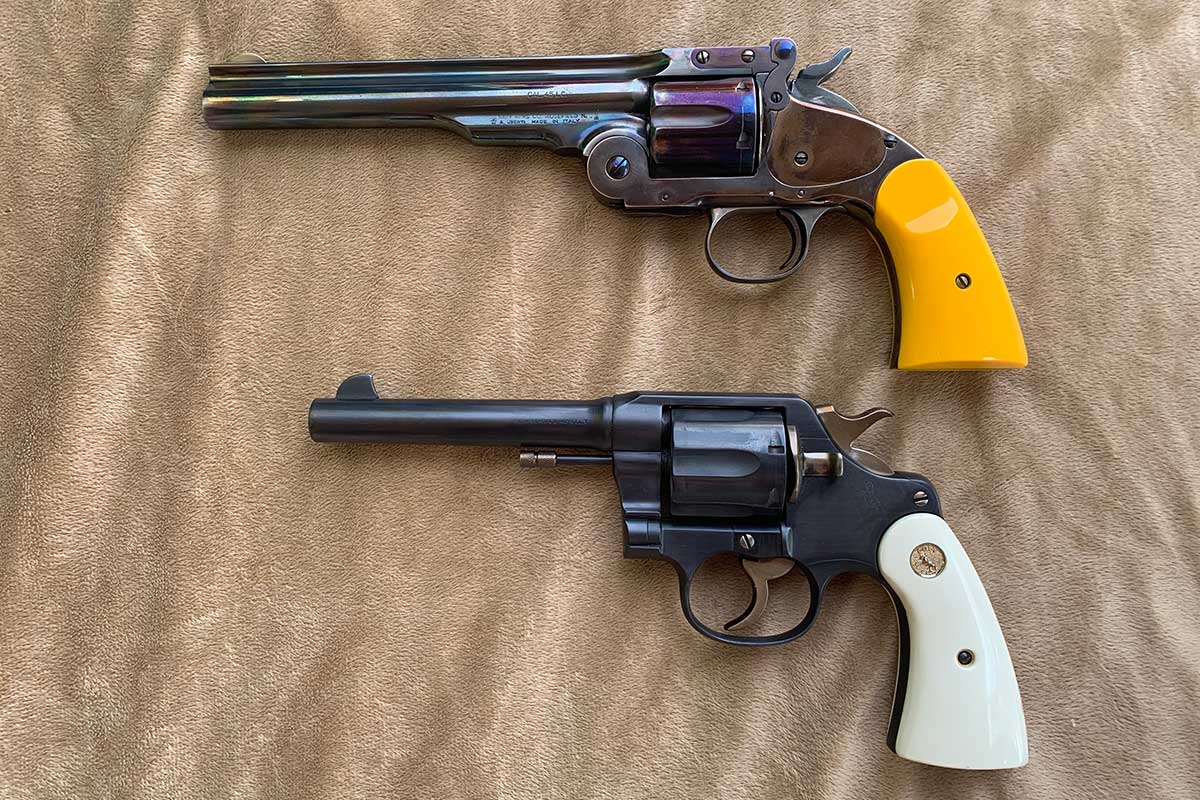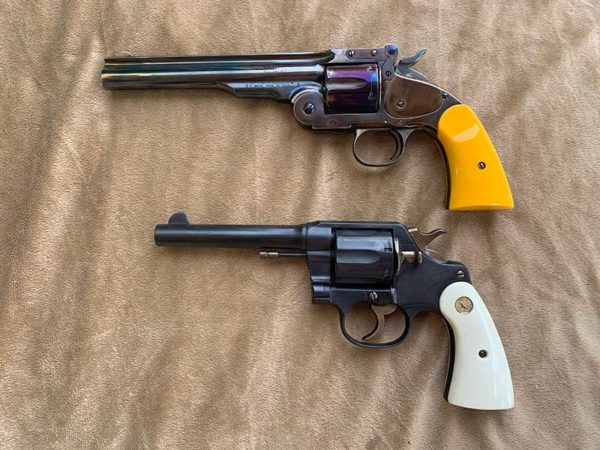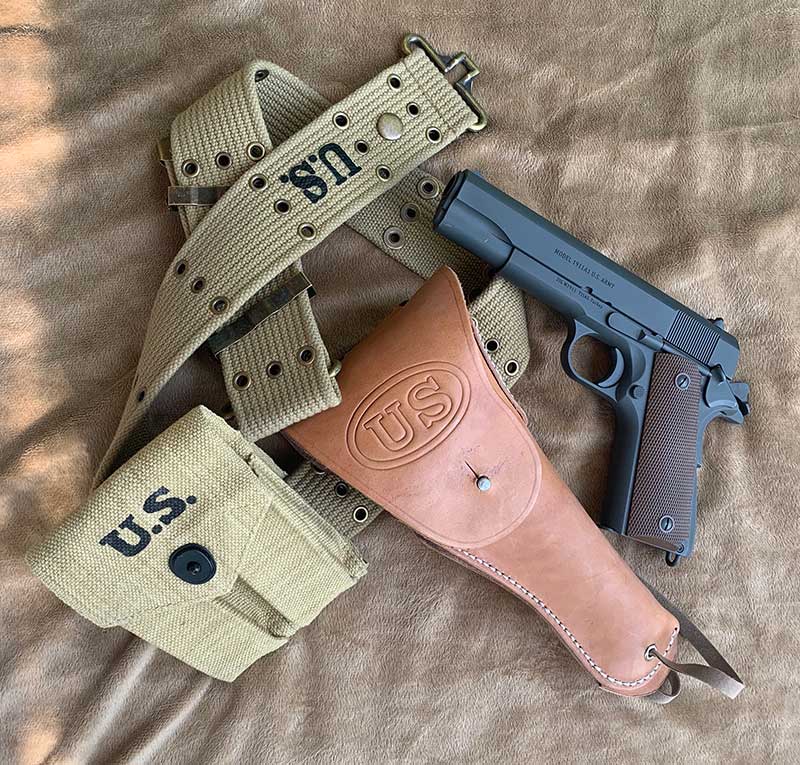
DRILLS
Instructors Lew Gosnell and Aimee Grant did a great job putting a spin on routine drills while keeping them fun. For example, on a man-against-man contest, rather than face the target and wait for the “fire” command, the shooters looked at each other and movement, by either contestant, was the signal to draw and fire. The first shooter to make a hit on the steel target won the “gunfight.”

Gunsmith David Fink chambers a round from the lever-action 1887 while empty shell is still in the air. Photo: Mike Detty

Gunsite Chief Executive Officer Ken Campbell, cutting loose with the Remington 11. Photo: Mike Detty
Revolvers are obviously slower to reload than the semi-autos, so just like shotguns we spent a lot of time loading what we shot—one-shot drill, load one round; two-round drill, load two rounds; failure drill, load three rounds, etc.
We shot a school drill where the possible score is 50 points. The twist here was that if a shooter did not shoot a perfect score, his final score was zero.
On the third day we shot one-handed from a saddle.
OLD WARHORSE
For the double-action day I used my Colt New Service, chambered in .45 Colt, made in 1907. Two years after this one was made, the U.S. Army adopted this large frame revolver as the Model 1909—two years before the iconic 1911 became the standard issue sidearm. A while back I had it expertly refinished for many more years of shooting, for both recreational use and self-defense (see New Life For a New Service https://gunsmagazine.com/gear/new-life-for-a-new-service/).
Although not as light and easy to conceal as almost any modern pistol, there is something comforting about a big heavy revolver that will launch a 250-gr. semi-wadcutter at 900 feet-per-second. For the event at Gunsite I used Black Hills Ammunition .45 Colt 250-gr. RNFP loads.
LOAD WHAT YOU SHOOT
In the movie the Shootist with John Wayne, when giving a shooting lesson, J.B. Books tells Gillum to leave the hammer down on an empty chamber for safety. When asked what if you’re expecting trouble, he says, “load six if your insides tell you to.”
Trying to keep the event as true to the period as possible, this became more difficult with the single-actions as they were to be reloaded, but with the hammer down on an empty chamber. Easier said than done. Remember Ruger did not come out with the transfer bar, which made carrying six rounds safely, until 1974.
A revolver I have taken to Gunsite for several events is my Uberti reproduction S&W Model 3 Schofield and the unique top-break revolver is always sure to attract interest and curiosity and due to the top-break action is easy to load and unload.

Retired Border Patrol officer Ed Head back in his element protecting the border from banditos. Photo: Mike Detty
Major George Schofield, serving with the 10th Cavalry in Kansas, learned of the No. 3 and became S&W’s sales agent for Colorado and Kansas. He later made some design changes and was granted patents that included a different latch and an improved extraction system. Hence the name Schofield was forever associated with the Smith & Wesson revolver.
The No. 3 has four hammer positions. After pulling the trigger, the hammer is all the way forward at rest with the integral firing pin protruding from the breech face.
Cocking the hammer to the first click retracts the firing pin, and the cylinder remains locked. This actually allows the Schofield to be carried fully loaded, although I’ve always been a bit wary about any “half-cocked” position—there is a good reason for the old saying, “Don’t go off half-cocked.”
Another click back unlocks the cylinder so that it rotates freely. In either one of these partially cocked positions, the latch can be activated and the barrel and cylinder rotated down to simultaneously eject the shells.
The fully cocked hammer position is all the way back ready to make a loud noise.
While the Uberti reproduction will also chamber .45 Colt, I used authentic .45 Schofield ammo from Black Hills Ammunition.
COMING TO AMERICA
For the semi-auto I took another reproduction—a 1911A1 imported by SDS Imports. Made in Turkey by TISAS, it is the closest reproduction of the gun used by the U.S. Army I have found. About the only thing different from the original is a magazine well that is slightly beveled and a polished feed ramp and barrel lip.
I didn’t just want to compete with the 1911A1, I wanted to give it as much of an evaluation during the short time I had with it as possible. Over the day I fired in excess of 200 rounds of mixed ammunition including 230-gr. full metal jacket, 228-gr. cast round nose lead and 200-gr. cast semi-wadcutters and did not experience a single malfunction.
Since I wanted to remain pure to the “period correct” theme, I used a GI flap holster on a web belt and web magazine pouches. I knew full well this would leave me out of the running in any man-against-man contests, but I did manage a respectable third place. Considering the flap was secured by the stud/hole arrangement on the holster I was quite content with my placing.
One of the differences between the 1911 and 1911A1 is the longer spur on the grip safety to avoid hammer bite. And although I was not bitten by the hammer, the narrow hammer spur caused enough discomfort to the web of my hand to make me appreciate the wide beavertail on modern 1911s.
One thing all three handguns had in common were the small and narrow front sight with matching small rear sights. As expected as distance increased, accuracy decreased even more than usual.
LAWDOG FOWLING PIECES
For a break from the late July Arizona sun, we had a show-and-tell session planned. When my turn came I brought out three shotguns that saw use by lawmen (and outlaws) in the early 1900s, and all three were John M. Browning designs. I have covered these extensively in my GUNS Magazine shotgun columns.
The first was a reproduction Winchester 1887 lever-action. This was a gun Browning really didn’t want do design, but Winchester insisted on it for brand identity.
Up next was an original Model 1897 made in 1907. This pump gun is probably the most identified shotgun used by U.S. troops in the trenches of World War I.

Class enjoyed hearing about and shooting historic shotguns. Top to bottom: Winchester Model 1887, Winchester Model 1897 and 1905 vintage Remington Model 11.
Finally I presented the Remington Model 11. Introduced initially as the Browning Auto-5, Remington purchased the rights to produce it starting in 1905. My Rem 11 is part of the first production run by Remington in 1905.
An interesting side note on the Remington 11 is that by rearranging friction rings on the magazine tube and recoil spring it can be set for either light or heavy loads and I demonstrated to the class how to accomplish this.
All attendees were given the chance to shoot each shotgun.
All shooting does not need to be tactical, or even practical for that matter. An event like this gives us the chance to kick back, reflect on our heritage and just have fun.
GUNSITE
(928) 636-4565
www.gunsite.com
BLACK HILLS AMMUNITION
(605) 348-5150
www.black-hills.com


One reply on “GUNS ACROSS THE BORDER | What Border Lawmen Used a Century Ago By Denny Hansen”
Thanks
I enjoyed your story.
Jon